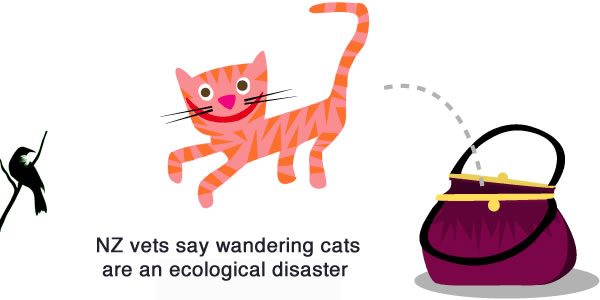Two years after we first put the cat amongst the pigeons with the Cats to Go campaign, the NZ Vets Association (NZVA) yesterday finally released their definitive, evidence-based position on the issue. The evidence in the report should finally settle the great cat debate: the naysayers will need to accept that cats do have an impact on our native wildlife. Now the question is – what do we do about it?
It is a testament to the sensitivity of this issue that the NZVA took so long to consider their response. They trawled the research, consulted their members, and reached a conclusion broadly the same as ours – albeit a bit less blunt. We will take a brief look at the research findings, before pondering how we can actually start to make progress on the issue of cat management. But in essence the NZVA has come up with the same conclusion that the international, peer reviewed evidence tells us, and the same thing we told New Zealand over two years ago – wandering cats are an ecological disaster and it doesn’t matter whether you call them feral, stray or companion.
Research findings
Probably the most interesting aspect of the findings is the estimated predation of companion and stray cats in New Zealand. For companion cats the total is put between 19-44 million animals per year, with a similar number (15-33 million) estimated for the smaller but hungrier stray cat population (200,000 strays as opposed to 1.4 million companion cats). Given recent video evidence, these numbers are pretty conservative. Of the companion cat total, 5-11 million are birds and 1-3 million reptiles – the latter possibly being an underestimate since reptiles seem to be more likely to be eaten by cats rather than returned home.
The other key finding relates to the policy of Trap, Neuter, Return (TNR), which has been backed by some branches of the SPCA. The research says it all:
The literature evaluated suggests that a Trap-Neuter-Return (TNR) strategy would not be judicious for the majority of stray cats as it is costly, does not stop predation of wildlife by cats and has little effect on the spread of diseases amongst cats. There is also little evidence that clearly shows TNR improves cat welfare overall or results in population decline on a broad scale.
Where to from here?
The research contains a number of recommendations around better cat management, all of which make complete sense. In fact, they are essential if we want to achieve a Predator Free New Zealand. The question is what role will different parts of society have to play to achieve this goal? We will look at each in turn.
Owners being responsible for their pets
Cat owners can no longer hide behind the fantasy that their cat doesn’t kill, or only kills selected species. Nor can they cling to the outmoded concept that cats are ‘free spirits’ and should be ‘free to roam’.
The NZVA is urging all cat owners to make sure their cat is identified. That means a collar, ideally with a bell, as well as a microchip. Over time, it will become commonplace for owners to keep their cats inside or on their property, especially in sensitive wildlife areas. Indoor cats are normal overseas, and if they get plenty of stimulation there is no impact on their welfare.
Government action is needed
This call from the NZVA – who are after all the professionals in the realm of animal welfare – gives the government the mandate it needs to start acting on cat management. The fact is that like most things, education of cat owners will never be the full answer, there will always be those that refuse to pull their weight. We need to move to managing cats in the same way we do dogs.
This means compulsory registration and micro-chipping to make it crystal clear which cats are owned and which are not. This allows owned cats to be returned to their owners – thereby preventing cats becoming lost or intentionally dumped by irresponsible owners. Once such a system is in place, any cats without a microchip can be dealt with accordingly – rehomed or euthanised.
In the mean time, Local Authorities can also act
Realistically it will take years for any government to draw up legislation and act. Politicians just want to be popular and so their ability to provide leadership is pathetic. In the meantime there are actions that Local Authorities can take. Many District Councils already limit cat numbers per household through bylaws.
Many Regional Councils also include feral cats in their Regional Pest Management Strategies, although they have no way to identify which cats fit which category. This resulted in a domestic cat being killed near Auckland recently. It may be possible to enforce micro-chipping of companion cats in sensitive wildlife areas to allow greater management of feral cats, while preventing the loss of further pet cats.
Which will allow an SPCA rethink
Local Authorities taking responsibility for stray cats would allow the SPCA to have a rethink of its trap, neuter and return policy. In many ways it is unfair to expect the SPCA to manage stray cats, Local Authorities have left it to them through a mere accident of history. No wonder that a society designed to protect animals would grow tired of euthanising them and would instead prefer to neuter and return them – regardless of whether it works.
NZVA’s research is a chance for a rethink. The SPCA should get behind NZVA’s calls for a national policy on cats, so that the issue of stray cat management is removed from their shoulders and the TNR policy can be gracefully abandoned. Then the SPCA can resume its mantle of being concerned for the welfare of all animals.

